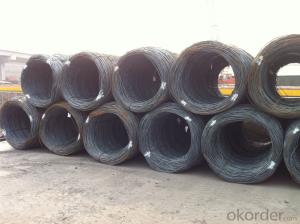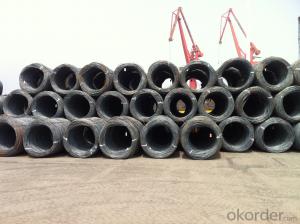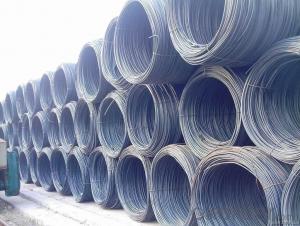Wire rod SAE1006-1008 with Highest Quality and Lowest Price
- Loading Port:
- Tianjin
- Payment Terms:
- TT OR LC
- Min Order Qty:
- 25 m.t
- Supply Capability:
- 20000 m.t/month
OKorder Service Pledge
OKorder Financial Service
You Might Also Like
Item specifice
OKorder is offering Hot Rolled Carbon Steel Wire Rod 5.5mm with High Quality at great prices with worldwide shipping. Our supplier is a world-class manufacturer of steel, with our products utilized the world over. OKorder annually supplies products to European, North American and Asian markets. We provide quotations within 24 hours of receiving an inquiry and guarantee competitive prices.
Product Applications:
Hot Rolled Carbon Steel Wire Rod 5.5mm with High Quality is widely used in construction and manufacturing. Carbon steel wire rod is mainly used for reinforcement of reinforced concrete and welded structure or reprocessed (roberts , nail, etc.) materials, especially used to produce wire drawing, welding electrode, nails, spring, electronic, precise machinery parts and so on.
Product Advantages:
OKorder's Hot Rolled Carbon Steel Wire Rod are durable, strong.packed and suitable for wire mesh,nail manufacture and construction
Main Product Features:
· Premium quality
· Prompt delivery & seaworthy packing (30 days after receiving deposit)
· Can be recycled and reused
· Mill test certification
· Professional Service
· Competitive pricing
Product Specifications:
Manufacture: Hot rolled
Grade: SAE1006 SAE1008 SAE1010 SAE1012 SAE1016 SAE1018
Certificates: ISO, SGS, BV, CIQ
Weight per Coil:2-2.05tons
Packaging: Export packing, packed by coil
Grade | Chemical Composition (%) | |||||
C | Mn | S | P | Si | B | |
SAE1006B | 0.03~O.07 | 0.32max | 0.045max | 0.040max | 0.30max | 0.0008min |
Mechanical properties | ||||||
Yield strength(N/mm2) | Tensile strength(N/mm2) | Elongation (%) | ||||
250-280 | 350-380 | ≥32 | ||||
Grade | Chemical Composition (%) | |||||
C | Mn | S | P | Si | B | |
SAE1008B | 0.10max | 0.3~0.50 | 0.050max | 0.040 max | 0.15max | 0.0008 min |
Mechanical properties | ||||||
Yield strength(N/mm2) | Tensile strength(N/mm2) | Elongation (%) | ||||
≥195 | 315-430 | ≥30 | ||||
FAQ:
Q1: Why buy Materials & Equipment from OKorder.com?
A1: All products offered byOKorder.com are carefully selected from China's most reliable manufacturing enterprises. Through its ISO certifications, OKorder.com adheres to the highest standards and a commitment to supply chain safety and customer satisfaction.
Q2: How do we guarantee the quality of our products?
A2: We have established an advanced quality management system which conducts strict quality tests at every step, from raw materials to the final product. At the same time, we provide extensive follow-up service assurances as required.
Q3:What's your payment terms ?
A3:Mostly,we collect the money by T/T and LC at sight . We also accept time LC at 90/120 days sight.
Image:


- Q:How does the thermal conductivity of steel wire rod vary with different grades?
- The thermal conductivity of steel wire rod typically varies with different grades. Higher-grade steel wire rod tends to have a higher thermal conductivity compared to lower-grade steel wire rod. This is because higher-grade steel wire rod is usually made with superior quality materials and has a more refined structure, allowing for better heat transfer. However, it is important to note that the exact variation in thermal conductivity can depend on various factors such as alloy composition, heat treatment, and processing techniques used during the manufacturing process.
- Q:What are the different surface defects that can occur during wire drawing?
- There are several surface defects that can occur during wire drawing, including scratches, pits, scale, cracks, and lumps. These defects can be caused by various factors such as improper lubrication, excessive drawing speed, inadequate cleaning of the wire, or issues with the drawing die. It is important to identify and address these defects promptly to ensure the quality and integrity of the wire.
- Q:What are the main factors affecting the market penetration of steel wire rod?
- The main factors affecting the market penetration of steel wire rod include the demand for steel wire rod in various industries such as construction, automotive, and manufacturing; the availability and cost of raw materials for production; competition from alternative materials; government regulations and trade policies; technological advancements in steel wire rod production and manufacturing processes; and economic factors such as GDP growth and consumer spending patterns.
- Q:How does the magnetic properties of steel wire rod vary with different heat treatment processes?
- The magnetic properties of steel wire rod can vary significantly with different heat treatment processes. Heat treatment involves subjecting the steel wire rod to controlled heating and cooling processes to alter its microstructure, which in turn affects its magnetic properties. One common heat treatment process used for steel wire rod is annealing. Annealing involves heating the rod to a specific temperature and then slowly cooling it to room temperature. This process helps to relieve internal stresses, refine the grain structure, and improve the ductility of the wire rod. In terms of magnetic properties, annealing can reduce the magnetic permeability of the steel wire rod, making it less susceptible to magnetic fields. This can be beneficial in applications where magnetic interference needs to be minimized. Another heat treatment process used for steel wire rod is quenching and tempering. Quenching involves rapidly cooling the wire rod from a high temperature to room temperature, typically by immersing it in a quenching medium such as oil or water. This rapid cooling results in a hard and brittle structure known as martensite. However, martensite is not magnetic and has low ductility. To improve the ductility and toughness of the wire rod, tempering is performed by reheating the quenched wire rod to a lower temperature and then allowing it to cool slowly. The tempering process partially transforms the martensite into a more ductile structure called tempered martensite. The magnetic properties of the wire rod after quenching and tempering can vary depending on the composition and cooling rate during quenching, as well as the temperature and duration of the tempering process. In summary, different heat treatment processes can have a significant impact on the magnetic properties of steel wire rod. Annealing can reduce the magnetic permeability, while quenching and tempering can alter the microstructure and magnetic behavior of the wire rod. The specific heat treatment process chosen will depend on the desired magnetic properties and the intended application of the steel wire rod.
- Q:What are the common applications of low carbon and oil tempered steel wire rod?
- Low carbon and oil tempered steel wire rods are commonly used in a variety of applications. Some of the common applications include manufacturing of springs, wire forms, mechanical fasteners, automotive components, construction materials, and agricultural implements. The low carbon content in the steel wire rod provides excellent formability and weldability, making it suitable for intricate and precise applications. The oil tempering process enhances the strength and durability of the wire, making it ideal for heavy-duty and high-stress applications where resistance to fatigue and deformation is required.
- Q:How is steel wire rod tested for impact resistance?
- Steel wire rods are tested for impact resistance through a standardized procedure known as Charpy or Izod test. In this test, a notched sample of the wire rod is placed in a pendulum impact tester. The pendulum is then released, striking the sample and causing it to fracture. The energy absorbed during fracture is measured, indicating the material's resistance to impact. This test helps determine the robustness and durability of the steel wire rod in various applications.
- Q:How is steel wire rod used in the manufacturing of wire forms for window blinds?
- Wire forms for window blinds require steel wire rod as a crucial component. This rod is chosen for its strength and durability, making it ideal for supporting the weight of blinds and enduring daily use. It is essential that the wire forms are sturdy enough to hold the blinds in place and withstand repeated opening and closing without losing their shape or functionality. To create the desired wire forms, the steel wire rod typically undergoes a series of manufacturing steps. These steps may include drawing, annealing, and coating processes. Drawing involves reducing the diameter of the rod by pulling it through dies, resulting in a thinner and more flexible wire. Annealing relieves internal stresses in the wire and enhances its ductility, making it easier to bend and shape. Coating processes may be applied to provide additional protection against corrosion or to enhance its appearance. Once the steel wire rod has been processed, it is transformed into various forms for window blinds, such as tilt rod connectors, cord connectors, and control brackets. Tilt rod connectors allow the slats in blinds to be tilted open or closed. Cord connectors secure the cords that control the raising and lowering of the blinds. Control brackets attach the blinds to the window frame and ensure stability. In summary, steel wire rod is crucial in the manufacturing of wire forms for window blinds. Its strength, durability, and versatility make it an excellent choice, ensuring the wire forms can withstand daily use and maintain functionality over time.
- Q:What is the difference between hot rolled and cold drawn steel wire rod?
- Hot rolled and cold drawn steel wire rods are both used in various industries for different applications. The main difference between the two lies in the manufacturing process. Hot rolled steel wire rod is produced by heating a billet or ingot to a high temperature and then rolling it through a series of rollers to achieve the desired shape and dimensions. This process results in a larger diameter and a rougher surface finish. Hot rolled steel wire rods are commonly used in construction, automotive, and machinery applications where strength and durability are important. They are also more cost-effective than cold drawn wire rods. On the other hand, cold drawn steel wire rod is produced by pulling the hot rolled wire rod through a series of dies at room temperature. This process results in a smaller diameter and a smoother surface finish compared to hot rolled wire rods. Cold drawn wire rods are commonly used in applications where precision and a smooth surface finish are required, such as in the manufacturing of precision components, automotive parts, and electrical conductors. In summary, the main difference between hot rolled and cold drawn steel wire rods is the manufacturing process, which affects the diameter, surface finish, and application suitability. Hot rolled wire rods are larger in diameter with a rougher surface finish, while cold drawn wire rods are smaller in diameter with a smoother surface finish. The choice between the two depends on the specific requirements of the application in terms of strength, precision, and surface finish.
- Q:What are the different types of steel wire rod drawing dies?
- There are several different types of steel wire rod drawing dies, each designed for specific applications and materials. 1. Single crystal diamond dies: These dies are made from a single crystal diamond and are known for their high wear resistance and durability. They are commonly used for drawing high carbon steel wires and other hard materials. 2. Polycrystalline diamond (PCD) dies: PCD dies are made from multiple small diamond grains that have been bonded together. They offer good wear resistance and are suitable for drawing medium to high carbon steel wires, stainless steel wires, and non-ferrous materials. 3. Tungsten carbide dies: These dies are made from a combination of tungsten and carbon, resulting in a material that is extremely hard and wear-resistant. They are commonly used for drawing low to medium carbon steel wires and non-ferrous wires. 4. Natural diamond dies: These dies are made from natural diamond, which offers excellent wear resistance and a smooth surface finish. They are typically used for drawing fine and ultra-fine wires, such as those used in the electronics industry. 5. PCD-coated dies: These dies have a layer of polycrystalline diamond coating applied to a tungsten carbide or steel substrate. They combine the wear resistance of PCD with the toughness of the substrate material, making them suitable for drawing a wide range of materials, including steel, stainless steel, and non-ferrous alloys. 6. Ceramic dies: Ceramic dies are made from materials such as tungsten carbide, alumina, or zirconia. They offer good wear resistance and can be used for drawing steel wires, stainless steel wires, and non-ferrous materials. Overall, the choice of steel wire rod drawing die depends on the specific application, wire material, and desired quality of the finished product. It is important to select the appropriate type of die to ensure optimal performance and longevity.
- Q:What are the common industry conferences for steel wire rod?
- Some common industry conferences for steel wire rod include the International Wire & Cable Trade Fair (wire), the International Wire & Machinery Association (IWMA) conference, and the Steel Success Strategies Conference.
1. Manufacturer Overview |
|
|---|---|
| Location | |
| Year Established | |
| Annual Output Value | |
| Main Markets | |
| Company Certifications | |
2. Manufacturer Certificates |
|
|---|---|
| a) Certification Name | |
| Range | |
| Reference | |
| Validity Period | |
3. Manufacturer Capability |
|
|---|---|
| a)Trade Capacity | |
| Nearest Port | |
| Export Percentage | |
| No.of Employees in Trade Department | |
| Language Spoken: | |
| b)Factory Information | |
| Factory Size: | |
| No. of Production Lines | |
| Contract Manufacturing | |
| Product Price Range | |
Send your message to us
Wire rod SAE1006-1008 with Highest Quality and Lowest Price
- Loading Port:
- Tianjin
- Payment Terms:
- TT OR LC
- Min Order Qty:
- 25 m.t
- Supply Capability:
- 20000 m.t/month
OKorder Service Pledge
OKorder Financial Service
Similar products
New products
Hot products
Hot Searches
Related keywords



























